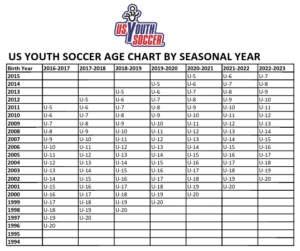Which year determines your age group? Youth soccer organizations move to clarify
Some detail-oriented people in youth soccer have noticed that a recently released U.S. Soccer document contradicts what several organizations have said about the new birth-year age group mandates.
T he U.S. Soccer document is correct. U.S. Youth Soccer advises clubs to use that document and will update its own documentation accordingly.
he U.S. Soccer document is correct. U.S. Youth Soccer advises clubs to use that document and will update its own documentation accordingly.
+READ: Dure: A fully legal way to set up youth soccer leagues not strictly by birth year
“The updated FAQ from U. S. Soccer is now posted on their web site,” U.S. Youth Soccer Director of Coaching Sam Snow told SoccerWire.com this week. “I would encourage all soccer clubs to utilize that resource.”
At issue: If your league runs a fall-to-spring season, mimicking a school year or a major European pro league season, which year do you use to compute the age groups? For the 2017-18 season, do you use 2017 or 2018?
The correct answer: 2018. From the U.S. Soccer document, which includes a correct chart:
Birth year registration should be based on the year in which the season ends. For example, if a season begins in the fall of 2017 and ends in the summer of 2018 (ex: 2017-18 season), the players would be registered based on their age in the year 2018. Competitions that take place in a single year (ex: fall of 2018 only) should use that year to determine birth year. To simplify determining the age group, just subtract the birth year from the year the season ends.
 Year Season Ends – Birth Year = Age Group:
Year Season Ends – Birth Year = Age Group:
2017-18 – 2003 = U15
2022-23 – 2016 = U7
2018 – 2012 = U6
A previously existing U.S. Youth Soccer chart (seen at right) shows age groups taken from the first half of a season. In 2017-18, according to this document, the 2003 birth-year players would play U-14, not U-15.
The mandates on birth-year age groups, along with similar mandates on small-sided games, do not go into effect until 2017-18. But many organizations, including U.S. Youth Soccer and U.S. Club Soccer, are going ahead with the switch to birth-year age groups in 2016-17.
The change will be profound for many players. A current U-9 player born after Aug. 1, 2006, will move straight to U-11 in the 2016-17 season. A current U-11 may go straight into U-13 competition, playing 11v11 on a full-sized field for the first time.
+READ: Resentment, conspiracy theories simmer as youth soccer bodies push birth-year change
While the rules would seem to allow leagues to declare a “season” to be a calendar year (or portion thereof) rather than a school year, there’s little sign of such a declaration on a national level, and U.S. Club Soccer has explicitly said it will stick with the current season: “Player passcards will continue to be issued on an Aug. 1-July 31 competition season.”
And the transition still has a few bumps to smooth out. Two U.S. Soccer documents linked from the same page offer contradictory information on one of the goals of the birth-year switch. The full PDF presentation, page 19, says one of the objectives of the birth-year switch is to “Combat relative age effect.” An accompanying FAQ says, “The player development initiatives do not claim to fix this issue.”
Meanwhile, clubs and leagues will have some leeway under the new rules to set up leagues to ease younger players into the sport.











